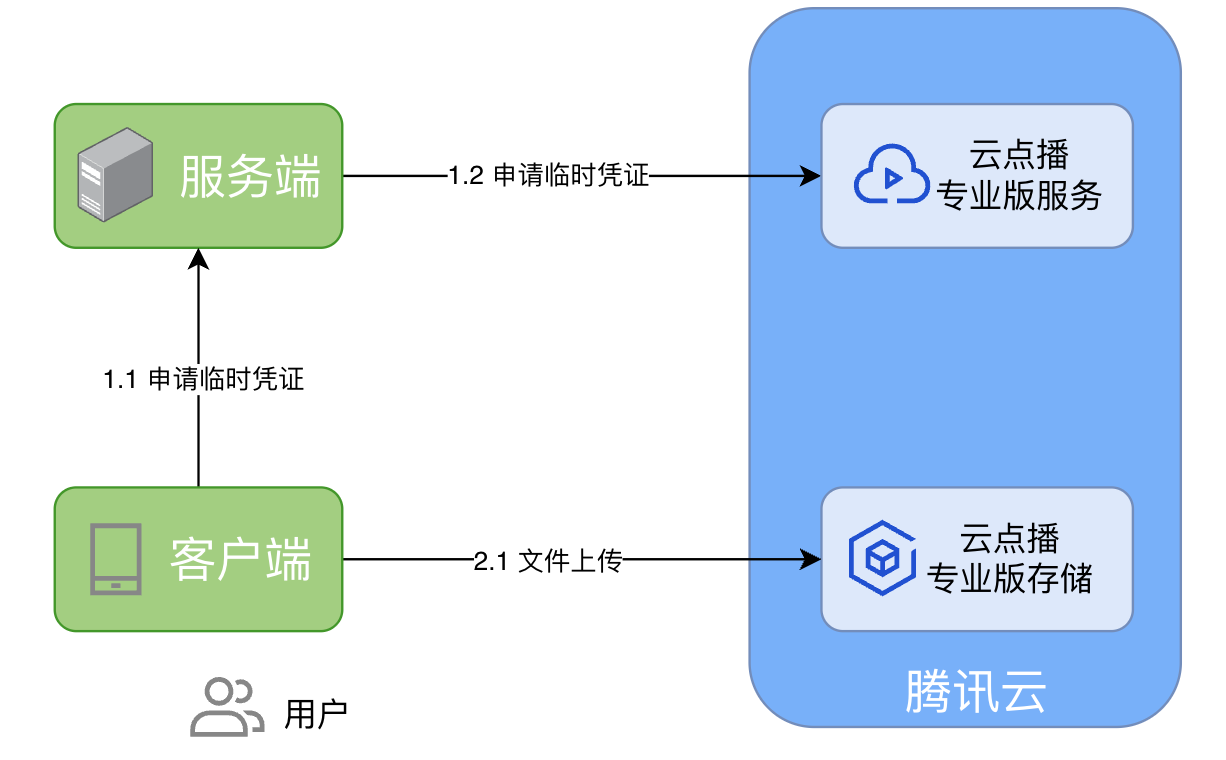本文主要提供专业版应用客户端上传指引。
适用场景
终端用户将客户端本地视频上传到云点播,适用于 UGC、PGC 等场景。
上传方式
客户端对密钥安全性要求较高,我们推荐通过专业版预置域名使用临时凭证上传,支持方式如下:
上传方式 | 上传域名 | 上传凭证 | 支持操作 |
存储桶预置域名 | [BucketId].vodpro.[存储地域].eovod.com | 临时凭证 | 上传至指定存储桶 |
应用预置域名 | [SubAppId].vodpro-upload.com | 临时凭证 | 上传至指定存储桶 就近上传至应用内某区域的存储桶 |
使用临时凭证上传文件
临时凭证通常用于对密钥安全性要求较高的场景。客户端使用临时凭证上传文件至专业版存储整体流程如下图:

1. 申请上传临时凭证
1.1 客户端向 App 后台申请上传临时凭证。
1.2 服务端调用云点播专业版服务 申请上传临时凭证。
2. 上传文件
客户端使用临时凭证上传文件至云点播专业版存储。
准备工作
1. 创建专业版应用和存储桶
2. 获取腾讯云账号永久密钥对
2.1 登录腾讯云控制台,选择访问管理 > 访问密钥 > API 密钥管理,进入“API 密钥管理” 页面。
2.2 获取云 API 密钥。如果您尚未创建密钥,则单击新建密钥即可创建一对
SecretId 和 SecretKey。服务端申请上传临时凭证
假设专业版应用 ID 为
1234567890 ,存储桶的存储地域为 ap-guangzhou,存储桶 ID 为 bucketid1。服务端申请
bucketid1存储桶上传 upload/demo.mp4的临时凭证,实现如下:// Package mainpackage mainimport ("context""encoding/json""fmt""log""net/url""github.com/tencentcloud/tencentcloud-sdk-go/tencentcloud/common""github.com/tencentcloud/tencentcloud-sdk-go/tencentcloud/common/profile"vod20240718 "github.com/tencentcloud/tencentcloud-sdk-go/tencentcloud/vod/v20240718")const (appId = 251000000 // 腾讯云账号 APPIDsubAppId = 1234567890 // 云点播专业版应用 APPIDbucketId = "bucketid1" // 云点播专业版应用存储桶的 IDfileKey = "upload/demo.mp4" // 上传到存储后的文件 KEY,包含完整路径和文件名,例如 upload/demo.mp4)// createStorageCredentialsPolicy 创建存储凭证策略type createStorageCredentialsPolicy struct {Statement []policyStatement `json:"statement"`Version string `json:"version"`}// policyStatement 策略语句type policyStatement struct {Action []string `json:"action"`Effect string `json:"effect"`Resource []string `json:"resource"`}// cred 临时凭证type cred struct {AccessKeyId stringSecretAccessKey stringSessionToken string}// getCredential 获取临时凭证func getCredential(context.Context) (*cred, error) {// 1. 获取临时凭证// 1.1 初始化调用腾讯云 API 对象credential := common.NewCredential("SecretId", // 腾讯云账号 SecretId"SecretKey", // 腾讯云账号 SecretKey)prof := profile.NewClientProfile()vodClient, err := vod20240718.NewClient(credential, "ap-guangzhou", prof)if err != nil {log.Fatalf("create VOD client fail: %+v", err)return nil, fmt.Errorf("create VOD client fail: %w", err)}// 1.2 构造申请上传临时凭证请求policy := createStorageCredentialsPolicy{Statement: []policyStatement{{Action: []string{ // 当前仅支持如下 action,可以只申请其中一部分"name/vod:PutObject","name/vod:ListParts","name/vod:PostObject","name/vod:CreateMultipartUpload","name/vod:UploadPart","name/vod:CompleteMultipartUpload","name/vod:AbortMultipartUpload","name/vod:ListMultipartUploads",},Effect: "allow",Resource: []string{fmt.Sprintf("qcs::vod:%s:uid/%d:prefix//%d/%s/%s","ap-guangzhou", // 存储桶所在地域appId, // 腾讯云账号 APPIDsubAppId, // 云点播专业版应用 APPIDbucketId, // 云点播专业版应用存储桶的 IDfileKey, // 上传到存储后的文件 KEY,包含完整路径和文件名,例如 upload/demo.mp4),},}},Version: "2.0",}req := vod20240718.NewCreateStorageCredentialsRequest()req.SubAppId = common.Uint64Ptr(subAppId)policyStr, _ := json.Marshal(policy)req.Policy = common.StringPtr(url.QueryEscape(string(policyStr)))// 1.3 申请上传临时凭证resp, err := vodClient.CreateStorageCredentials(req)if err != nil {log.Fatalf("create storage credentials fail: %+v", err)return nil, fmt.Errorf("create storage credentials fail: %w", err)}log.Printf("create storage credentials success: %+v", resp)creds := resp.Response.Credentialsreturn &cred{AccessKeyId: *creds.AccessKeyId,SecretAccessKey: *creds.SecretAccessKey,SessionToken: *creds.SessionToken,}, nil}
import com.tencentcloudapi.common.Credential;import com.tencentcloudapi.common.exception.TencentCloudSDKException;import com.tencentcloudapi.common.profile.ClientProfile;import com.tencentcloudapi.vod.v20240718.VodClient;import com.tencentcloudapi.vod.v20240718.models.CreateStorageCredentialsRequest;import com.tencentcloudapi.vod.v20240718.models.CreateStorageCredentialsResponse;import org.json.JSONArray;import org.json.JSONObject;import java.net.URLEncoder;import java.nio.charset.StandardCharsets;/*** 凭证辅助类,负责获取临时存储凭证*/public class CredentialHelper {// 常量定义private static final long APP_ID = 251000000; // 腾讯云账号 APPIDprivate static final long SUB_APP_ID = 1234567890; // 云点播专业版应用 APPIDprivate static final String BUCKET_ID = "bucketid1"; // 云点播专业版应用存储桶的 IDprivate static final String FILE_KEY = "upload/demo.mp4"; // 上传到存储后的文件 KEYprivate static final String REGION = "ap-guangzhou"; // 存储桶所在地域/*** 凭证对象,存储临时凭证信息*/public static class Cred {private final String accessKeyId;private final String secretAccessKey;private final String sessionToken;public Cred(String accessKeyId, String secretAccessKey, String sessionToken) {this.accessKeyId = accessKeyId;this.secretAccessKey = secretAccessKey;this.sessionToken = sessionToken;}public String getAccessKeyId() {return accessKeyId;}public String getSecretAccessKey() {return secretAccessKey;}public String getSessionToken() {return sessionToken;}}/*** 获取临时凭证** @return 临时凭证对象* @throws Exception 如果获取凭证失败*/public static Cred getCredential() throws Exception {try {// 1. 初始化腾讯云 API 客户端Credential credential = new Credential("SecretId", "SecretKey"); // 腾讯云账号 SecretId 和 SecretKeyClientProfile clientProfile = new ClientProfile(); // 客户端配置VodClient vodClient = new VodClient(credential, "ap-guangzhou", clientProfile); // 创建 VodClient 对象// 2. 构造并编码策略String policyJson = createPolicyJson();String encodedPolicy = URLEncoder.encode(policyJson, StandardCharsets.UTF_8.name());// 3. 创建并发送请求CreateStorageCredentialsRequest req = new CreateStorageCredentialsRequest();req.setSubAppId(SUB_APP_ID); // 云点播专业版应用 APPIDreq.setPolicy(encodedPolicy); // 策略// 4. 获取响应并返回凭证CreateStorageCredentialsResponse resp = vodClient.CreateStorageCredentials(req);return new Cred(resp.getCredentials().getAccessKeyId(),resp.getCredentials().getSecretAccessKey(),resp.getCredentials().getSessionToken());} catch (TencentCloudSDKException e) {System.err.println("获取存储凭证失败: " + e.getMessage());throw new Exception("获取存储凭证失败", e);}}/*** 创建策略JSON字符串,使用 org.json 库** @return 策略JSON字符串*/private static String createPolicyJson() {// 构建资源路径String resource = String.format("qcs::vod:%s:uid/%d:prefix//%d/%s/%s",REGION,APP_ID,SUB_APP_ID,BUCKET_ID,FILE_KEY);// 构建操作列表String[] actions = {"name/vod:PutObject","name/vod:ListParts","name/vod:PostObject","name/vod:CreateMultipartUpload","name/vod:UploadPart","name/vod:CompleteMultipartUpload","name/vod:AbortMultipartUpload","name/vod:ListMultipartUploads"};// 使用 JSONObject 构建 JSONJSONObject policy = new JSONObject();policy.put("version", "2.0");JSONArray statements = new JSONArray();JSONObject statement = new JSONObject();JSONArray actionArray = new JSONArray();for (String action : actions) {actionArray.put(action);}statement.put("action", actionArray);statement.put("effect", "allow");JSONArray resources = new JSONArray();resources.put(resource);statement.put("resource", resources);statements.put(statement);policy.put("statement", statements);return policy.toString();}}
#include <tencentcloud/core/TencentCloud.h>#include <tencentcloud/core/profile/ClientProfile.h>#include <tencentcloud/core/profile/HttpProfile.h>#include <tencentcloud/core/Credential.h>#include <tencentcloud/vod/v20240718/VodClient.h>#include <tencentcloud/vod/v20240718/model/CreateStorageCredentialsRequest.h>#include <tencentcloud/vod/v20240718/model/CreateStorageCredentialsResponse.h>#include <string>#include <sstream>#include <iomanip>#include <iostream>#include <nlohmann/json.hpp>using json = nlohmann::json;const uint64_t APP_ID = 251000000; // 腾讯云账号 APPIDconst uint64_t SUB_APP_ID = 1234567890; // 云点播专业版应用 APPIDconst std::string BUCKET_ID = "bucketid1"; // 云点播专业版应用存储桶的 IDconst std::string REGION = "ap-guangzhou"; // 云点播专业版应用存储桶地域const std::string OBJECT_KEY = "upload/demo.mp4"; // 申请权限的存储文件 KEY// 凭证结构体struct Credential{std::string accessKeyId;std::string secretAccessKey;std::string sessionToken;};// URL 编码函数std::string UrlEncode(const std::string &value){std::ostringstream escaped;escaped.fill('0');escaped << std::hex;for (char c : value){if (isalnum(c) || c == '-' || c == '_' || c == '.' || c == '~'){escaped << c;}else{escaped << std::uppercase;escaped << '%' << std::setw(2) << int((unsigned char)c);escaped << std::nouppercase;}}return escaped.str();}// 获取临时凭证Credential GetCredential(){// 初始化腾讯云 SDKTencentCloud::InitAPI();// 创建 VOD 客户端TencentCloud::Credential credential("SecretId", "SecretKey"); // 填入腾讯云账号 SecretId 和 SecretKeyTencentCloud::HttpProfile httpProfile;TencentCloud::ClientProfile clientProfile;clientProfile.SetHttpProfile(httpProfile);TencentCloud::Vod::V20240718::VodClient client(credential, "ap-guangzhou", clientProfile);// 构建策略json policy_json = {{"statement", {{{"action", {"name/vod:PutObject", "name/vod:ListParts", "name/vod:PostObject", "name/vod:CreateMultipartUpload", "name/vod:UploadPart", "name/vod:CompleteMultipartUpload", "name/vod:AbortMultipartUpload", "name/vod:ListMultipartUploads"}}, {"effect", "allow"}, {"resource", {"qcs::vod:" + REGION + ":uid/" + std::to_string(APP_ID) + ":prefix//" + std::to_string(SUB_APP_ID) + "/" + BUCKET_ID + "/" + OBJECT_KEY}}}}},{"version", "2.0"}};std::string policy = policy_json.dump();// 创建请求对象TencentCloud::Vod::V20240718::Model::CreateStorageCredentialsRequest req;req.SetSubAppId(SUB_APP_ID);req.SetPolicy(UrlEncode(policy));// 发送请求auto outcome = client.CreateStorageCredentials(req);if (!outcome.IsSuccess()){std::cerr << "Failed to get storage credentials: " << outcome.GetError().GetErrorMessage() << std::endl;TencentCloud::ShutdownAPI();exit(1);}// 提取凭证auto response = outcome.GetResult();auto creds = response.GetCredentials();Credential result;result.accessKeyId = creds.GetAccessKeyId();result.secretAccessKey = creds.GetSecretAccessKey();result.sessionToken = creds.GetSessionToken();// 清理腾讯云 SDKTencentCloud::ShutdownAPI();return result;}
#!/usr/bin/env python3# -*- coding: utf-8 -*-import jsonimport urllib.parsefrom typing import NamedTuplefrom tencentcloud.common import credentialfrom tencentcloud.common.profile import client_profilefrom tencentcloud.vod.v20240718 import vod_client, models# 常量定义APP_ID = 251000000 # 腾讯云账号 APPIDSUB_APP_ID = 1234567890 # 云点播专业版应用 APPIDBUCKET_ID = "bucketid1" # 云点播专业版应用存储桶的 IDOBJECT_KEY = "upload/demo.mp4" # 上传到存储后的文件 KEYREGION = "ap-guangzhou" # 地域class Credential(NamedTuple):"""临时凭证"""access_key_id: strsecret_access_key: strsession_token: strdef get_credential() -> Credential:"""获取临时凭证"""# 1. 初始化调用腾讯云 API 对象cred = credential.Credential("SecretId", # 腾讯云账号 SecretId"SecretKey", # 腾讯云账号 SecretKey)prof = client_profile.ClientProfile()vod_cli = vod_client.VodClient(cred, "ap-guangzhou", prof)# 2. 构造申请上传临时凭证请求policy = {"statement": [{"action": ["name/vod:PutObject","name/vod:ListParts","name/vod:PostObject","name/vod:CreateMultipartUpload","name/vod:UploadPart","name/vod:CompleteMultipartUpload","name/vod:AbortMultipartUpload","name/vod:ListMultipartUploads",],"effect": "allow","resource": [f"qcs::vod:{REGION}:uid/{APP_ID}:prefix//{SUB_APP_ID}/{BUCKET_ID}/{OBJECT_KEY}"],}],"version": "2.0",}req = models.CreateStorageCredentialsRequest()req.SubAppId = SUB_APP_IDreq.Policy = urllib.parse.quote(json.dumps(policy))# 3. 申请上传临时凭证resp = vod_cli.CreateStorageCredentials(req)creds = resp.Credentialsreturn Credential(access_key_id=creds.AccessKeyId,secret_access_key=creds.SecretAccessKey,session_token=creds.SessionToken,)
使用 SDK 上传文件
下面介绍在常用的客户端 SDK 中,如何进行适配以上传文件至专业版应用的存储桶。
域名
专业版为每个应用预置了一个上传加速域名,应用下所有存储桶均可使用该域名进行上传。
示例使用的应用上传加速域名均为:
1234567890.vodpro-upload.com。